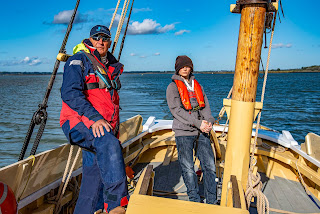So, here we are in the second week in May. Normally, we
would be out on the water – taking groups of young people or adults sailing on
PIONEER and learning about the environment, working together and establishing
social contact. But as we all know, these are not ‘normal’ times and instead of
standing on the gently moving deck of the 156 year old Class A smack, feeling
the wind on your face and perhaps the odd splash of salt spray, we find
ourselves indoors and locked down.
All of a sudden, there is a feeling of what am I going to do
with myself over the next few weeks? As a boaty sort of person, if I can’t get
out on the water, then at least I can prepare for the end of lockdown when I
can get afloat! Some years ago, my wife bought me a kit of parts for a rowing
skiff. The crate has remained in my garage, unopened, for about 8 years,
waiting for the opportunity when I can devote some time to its construction.
Lockdown has certainly given me that opportunity!

I haven’t had the benefit of a Boat Building apprenticeship
at the Pioneer Trust, so I must admit my boat-building skills pale into
insignificance when compared with the skills and projects undertaken by the
Apprentices already covered in this Blog. But, the pre-cut plywood panels that
are ‘stitched’ together with wire soon bring a few bits of wood into a pretty
sleek-looking rowing wherry. The seams are glued together with epoxy and
fibre-glass taped over both inside and out. This recognised ‘stitch and glue’
construction method makes for a stiff and strong monocoque hull with only three
final frames epoxied in place to help maintain shape and strength.

Progress has been in fits and starts as there have been
other things to get on with at home! As I write this, I still have the
gunwhales to finish, the out-riggers to fit and sliding seat framework to build
and fit. Then there is the not-so-small job of sanding and painting her, but I
certainly hope to have the boat afloat and rowing in Brightlingsea Creek just
as soon as possible.





No comments:
Post a Comment